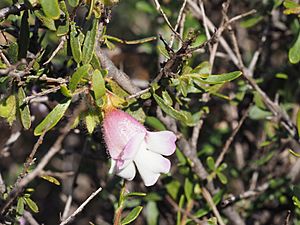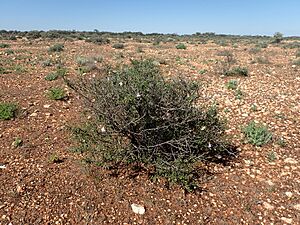Eremophila spinescens facts for kids
Quick facts for kids Eremophila spinescens |
|
|---|---|
 |
|
| Eremophila spinescens leaves and flower | |
| Scientific classification | |
| Genus: |
Eremophila (plant)
|
| Species: |
spinescens
|
Eremophila spinescens is a type of flowering plant that belongs to the figwort family, also known as Scrophulariaceae. This plant is special because it is only found naturally in Western Australia. It's a low, spreading shrub that has stiff, spiny branches, small leaves, and pretty lilac to dark purple flowers.
Contents
What Does Spiny Poverty Bush Look Like?
Eremophila spinescens is a shrub that usually grows to be about 30 to 60 centimeters (1 to 2 feet) tall. It has stiff branches that get spiny as they grow older.
Its leaves grow one after another along the branches. They are spread out, except on shorter side branches where they grow in bunches. The leaves are long and narrow, usually about 5 to 19 millimeters (0.2 to 0.7 inches) long and 0.5 to 3 millimeters (0.02 to 0.1 inches) wide. Most of them are smooth, without hairs.
Flowers and Fruits
The flowers grow one by one where the leaves meet the stem, on hairy stalks that are usually 3 to 12 millimeters (0.1 to 0.5 inches) long. Each flower has five green or purplish sepals, which are like small leaves that protect the bud. These sepals are about 3.5 to 9 millimeters (0.1 to 0.4 inches) long and are hairy.
The petals are 15 to 20 millimeters (0.6 to 0.8 inches) long and are joined together at the bottom to form a tube. The outside of this tube is lilac to dark purple. Inside, it's white or cream-colored with dark purplish-black stripes. The outside of the petal tube and its tips are hairy. The inside of the tips is smooth, but the inside of the tube is full of soft, woolly hairs. The four stamens (the parts that make pollen) are hidden inside the petal tube.
This plant usually flowers from April to October, especially after it rains. After the flowers, it grows fruits that are dry, woody, and oval-shaped or almost round. They are hairy and about 6 to 9 millimeters (0.2 to 0.4 inches) long, with a shiny, papery covering.

Where Does Spiny Poverty Bush Grow?
Spiny poverty bush grows in sandy, clay, or loam soils. You can find it in areas between Wiluna and Carnegie Station in Western Australia. These areas include the Gascoyne, Little Sandy Desert, and Murchison regions.
Growing Spiny Poverty Bush in Your Garden
If you're thinking about growing this plant, you need to be careful where you put it. Its branches become spiny as they get older, so pick a spot where people won't accidentally bump into it.
Even with its spines, it's a very attractive plant with small, dark-green leaves and beautiful lilac flowers. You can start new plants from cuttings. It grows best in soil that drains well and in a spot that gets lots of sun. This plant is very good at handling dry weather, so it rarely needs watering even during long dry periods. It might lose some leaves if it gets very dry. Once it's fully grown, it can usually handle frost well.
Images for kids



